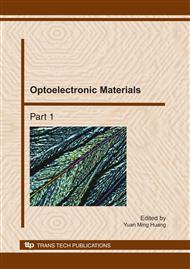p.68
p.72
p.76
p.80
p.84
p.88
p.92
p.96
p.100
Effect of Dy Ions on Optical Properties of Sr0.985-X Al2O4: Eu2+0.015Dy3+x Phosphors
Abstract:
A series of long persistent phosphors Sr0.985-x Al2O4 : Eu2+0.015Dy3+x (X=0.000, 0.010, 0.020, 0.030, 0.040) were prepared through a combustion method at 600oC. We found that all the series of samples have good long afterglow properties by the naked eye. Then we use the laser to stimulate phosphors at 325nm, and their emission spectrums were tested by a spectrograph. We can found that the main emission peaks of all samples are all results from the 4f65d 4f7 (8S7/2) transition of Eu2+ instead of the 4f7 (6P7/2) 4f7 (8S7/2) transition of Eu2+ ions located about 515nm. In addition, the afterglow characteristic of all samples was investigated. Our results show that each decay curve consists of a rapid decay part followed by a long slow one and all samples have the same afterglow mechanism. And the Dy ions play an important role on the afterglow process.
Info:
Periodical:
Pages:
84-87
Citation:
Online since:
November 2010
Authors:
Price:
Сopyright:
© 2011 Trans Tech Publications Ltd. All Rights Reserved
Share:
Citation:


